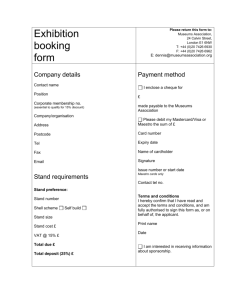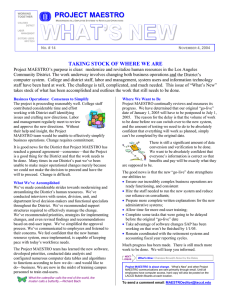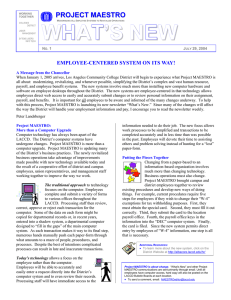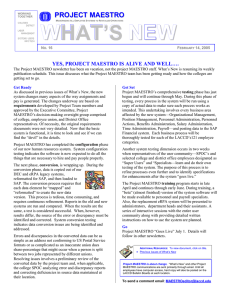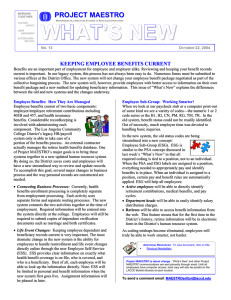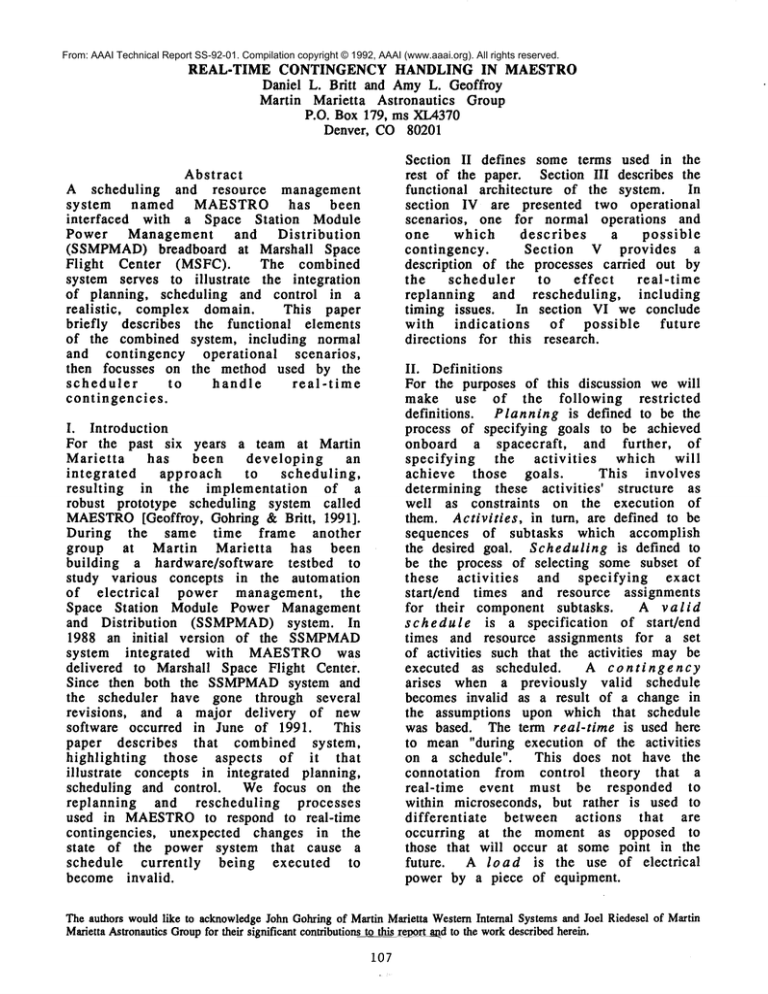
From: AAAI Technical Report SS-92-01. Compilation copyright © 1992, AAAI (www.aaai.org). All rights reserved.
REAL-TIME
CONTINGENCY HANDLING IN MAESTRO
Daniel L. Britt and AmyL. Geoffroy
Martin Marietta Astronautics
Group
P.O. Box 179, ms XL4370
Denver, CO 80201
Section II defines some terms used in the
rest of the paper. Section III describes the
functional
architecture
of the system. In
section IV are presented
two operational
scenarios,
one for normal operations
and
one which
describes
a possible
contingency.
Section
V provides
a
description
of the processes carried out by
the scheduler
to effect
real-time
replanning
and rescheduling,
including
timing issues.
In section VI we conclude
with indications
of possible
future
directions for this research.
Abstract
A scheduling
and resource
management
system
named
MAESTRO has
been
interfaced
with a Space Station
Module
Power Management
and Distribution
(SSMPMAD) breadboard
at Marshall Space
Flight
Center (MSFC).
The combined
system serves to illustrate
the integration
of planning,
scheduling
and control in a
realistic,
complex domain.
This paper
briefly
describes the functional
elements
of the combined system, including
normal
and contingency
operational
scenarios,
then focusses
on the method used by the
scheduler
to
handle
real-time
contingencies.
I. Introduction
For the past six years a team at Martin
Marietta
has been
developing
an
integrated
approach
to scheduling,
resulting
in the implementation
of a
robust prototype scheduling system called
MAESTRO
[Geoffroy, Gohring & Britt,
1991].
During
the same time frame another
group at Martin
Marietta
has been
building a hardware/software
testbed to
study various concepts in the automation
of electrical
power management,
the
Space Station
Module Power Management
and Distribution
(SSMPMAD) system.
1988 an initial
version
of the SSMPMAD
system
integrated
with MAESTRO was
delivered to Marshall Space Flight Center.
Since then both the SSMPMADsystem and
the scheduler
have gone through several
revisions,
and a major delivery
of new
software occurred
in June of 1991. This
paper describes
that combined system,
highlighting
those aspects
of it that
illustrate
concepts in integrated planning,
scheduling
and control.
We focus on the
replanning
and rescheduling
processes
used in MAESTROto respond to real-time
contingencies,
unexpected changes in the
state
of the power system that cause a
schedule
currently
being executed
to
become invalid.
II. Definitions
For the purposes of this discussion we will
make use of the following
restricted
definitions.
Planning is defined to be the
process of specifying goals to be achieved
onboard a spacecraft,
and further,
of
specifying
the activities
which will
achieve those goals.
This involves
determining these activities’
structure
as
well as constraints
on the execution
of
them. Activities,
in turn, are defined to be
sequences
of subtasks
which accomplish
the desired goal. Scheduling is defined to
be the process of selecting
some subset of
these activities
and specifying
exact
start/end
times and resource assignments
for their
component subtasks.
A valid
schedule is a specification
of start/end
times and resource assignments
for a set
of activities
such that the activities
may be
executed
as scheduled.
A contingency
arises
when a previously
valid schedule
becomes invalid as a result of a change in
the assumptions upon which that schedule
was based. The term real-time is used here
to mean "during execution of the activities
on a schedule".
This does not have the
connotation
from control
theory that a
real-time
event must be responded
to
within microseconds, but rather is used to
differentiate
between actions
that are
occurring
at the moment as opposed to
those that will occur at some point in the
future.
A load is the use of electrical
power by a piece of equipment.
Theauthors wouldlike to acknowledge
JohnGohringof MartinMariettaWesternInternal SystemsandJoel Riedeselof Martin
MariettaAstronautics
Group
for their significantcontributionsto this rej~ort~dto the workdescribedherein.
107
III. Functional Architecture
Figure 1 depicts the functional elements of
the combined
SSMPMAD/MAESTROsystem
and relationships
among these elements.
Briefly, the Activity Editor is used to create
definitions
for
activities
which
accomplish
goals desired
by the user.
MAESTROis used to select
and schedule a
subset of these activities,
and to save the
resultant
schedule(s)
out to files.
The
Transaction
Manager (TM) serves
as
communications port, facilitating
specific
types
of communications
between
MAESTRO
and the rest of the system during
breadboard operation.
The Front End Load
Enable
Scheduler
(FELES)
creates
schedules of power system events (such as
closing
switches)
from saved schedule
files.
The Communications
and
Algorithmic
Controller
(CAC) distributes
schedules among Load Centers (LCs), into
which are incorporated
Lowest Level
Processors
(LLPs). These LLPs actually
control
hardware switches
on the power
system breadboard,
as well as monitoring
the states
of various sensors distributed
throughout
the system.
The Fault
Recovery And Management Expert System
(FRAMES) performs
fault
isolation,
diagnosis
and recovery
for the power
system,
and communicates
with the
scheduler during real-time
contingencies.
The Load Priority
List Management System
(LPLMS) maintains a list of active loads
a prioritized
order such that if there is a
need
to
quickly
reduce
power
consumption
in a portion
of the
breadboard, loads can be shed (turned off)
in an order that minimizes the impact of
this load shedding.
I
Fault Recovery and
I Management Expert System I
MAESTRO] Transaction
Scheduling I Manager
Ih..J
" I
I Communicationsand
System]
Fro:t
J (Schedule
Library
~ LEO:die
]
~’~1
Algorithmic
Control
Scheduler
T
(Activity
Library
ctivity
A
Editor
i
J
Figure
1. Functional
¯,.tMomt
I
System
architecture
Power System Hardware
I
of the MAESTRO/SSMPMAD
combined system.
overloading
any of the lower-level
RPCs
connected
to it. For this reason it is
necessary
to represent
the entire
power
path for each power-using resource to the
scheduling
system,
rather
than just
representing
total
power consumed by
each activity.
A portion of the actual power circuits
on
the breadboard
is depicted
in figure 2.
Note that several 1-kilowatt
Remote Power
Controllers
(RPCs) can be attached
to
single 3-kilowatt RPC. Thus it is possible to
overload
an intermediate
RPC without
108
PowerStar BusA
PDCUA
LLP
.
"~-
"I
A/D
~- to other load centers
from Bus B PDCU
Load Center
Figure 2. Representative
Load Center
schematic of a portion
IV. Operational Scenarios
Normally, a user will interact
with the
activity editor to create a set of activities to
be scheduled,
saving these activities’
definitions
in an activity
library.
In that
or another session,
the user will run the
scheduler
to create one or more initial
schedules
of these activities.
These
schedules
will be saved into a schedule
library.
When a user wishes to operate
the power system breadboard,
s/he uses
the SSMPMADinterface
to select
a saved
schedule, initialize
the system and execute
that schedule.
The FELES first
obtains a
saved schedule and translates
a portion of
it (roughly one-half hour of activity)
into
a series
of power
system
events,
specifying
at what times and power levels
each RPC is to be turned on. The LPLMS
takes this schedule of power system events
and creates a list of loads to shed in an
emergency power reduction.
The event
schedule and priority
list are transmitted
to the CAC, which distributes
them among
the LLPs as appropriate.
The CAC also
maintains
a system clock, coordinating
timing for the various elements.
109
PDCU:
powerdistribution
controlunit
LLP:lowestlevel processor
A/D:Analog-to-digital
converter
SIC:switchgear
interface
controller
RemotePower
.=1=
Controller(RPC)
=r
1 or 3 kW
of the SSMPMAD
breadboard.
Execution
of the distributed
schedule
proceeds with the LLPs directing
the RPCs
to close and open switches at the times
specified
by their
respective
event
The RPCs monitor voltage,
schedules.
current,
temperature
and
other
parameters of their operations.
Prior to the expiration
of the timeline
increment being executed,
the FELES will
acquire another increment from the saved
schedule,
translate
it into power system
events, and transfer
it to the CAC, which
distributes
it to the LLPs. At a specified
time, the LLPs stop executing
the old
increment event list
and begin executing
the new one.
When an anomalous
condition
(such as
over-current
or under-voltage
at a
switch) is detected by one of the RPCs, it
automatically
takes a sating
action,
if
possible.
The LLP controling
it reports
this
event to FRAMES, which gathers
together
all available
information
about
the fault, isolates it, and compiles a list of
system configuration
status
changes
resulting
from the fault.
These changes
can include
a load being switched
to a
redundant
power source
(redundancy
switching),
an RPC going out of service,
the deliberate
shutdown of a load to reduce
power consumption (load shedding),
or
reduction
in power available
at an RPC
and the expected
duration
of that
reduction.
This list
of changes is then
communicated
to the scheduler,
which
revises the activity schedule to reflect the
changes
and makes the new schedule
available
to the FELES. It creates a new
event list, which is distributed
to the LLPs
along with a time tag indicating
when to
begin executing the new schedule.
V. The Real-Time Rescheduling
Process
When a power system anomaly occurs,
MAESTROwill get a set of information
from FRAMES throught
the TM. This
information will include the current
time
in addition
to redundancy switch,
load
shed, power availability
change, and RPC
out-of-service
messages. These messages
will include the time the event occurred,
and if
applicable
the duration
of the
change.
MAESTROfollows
a three-step
process
to handle
these
messages
and
revise
the schedule.
It 1) modifies
the
schedule to reflect
changes made to it by
the power system and to remove resource
and temporal
constraint
violations
for
activities
not yet begun, 2) tries to find
ways to create and schedule continuations
for interrupted
activities,
and 3) tries to
schedule
any activities
that can take
advantage of the resources released by the
interruption
of others.
The first
step
results
in a valid but possibly not very
efficient
schedule.
It is carried out as
quickly
as possible
to ensure
that a
workable schedule
can be in place soon,
reducing the likelihood
that adherence by
the power system to the old (invalid)
schedule will result in a cascade of faults
registered
by that system. The second and
third steps will only be attempted if there
is sufficient
time to get something useful
done. Management of its own computation
time is a difficult
issue for a real-time
rescheduler.
It must project a time when
it will have a valid schedule available,
including the time it takes to transmit that
schedule to the entities
responsible
for
carrying it out, then not make changes to
the schedule
(other
than those already
made by the power system)
that
would
need to be acted upon before
they are
110
received
by the power system.
For
example, if at 10:00 a contingency occurs,
and the scheduler
determines
that
an
interrupted
activity
can be continued at
10:05, but
this information
cannot be
transmitted
to the power system until
10:08, then the schedule is invalid
the
moment the system begins to execute it.
In this
example
the scheduler
could
specify that the activity
be continued at
10:08, but not before.
The actual structure
used to control
the
three-step
process mentioned above is a
prioritized
list of command queues.
As
information
comes in from FRAMES, it is
routed to one of several command queues,
for action as soon as MAESTRO
has nothing
more important to take care of. Resource
availability
changes appear in one queue,
while redundancy switches are in another
and load sheds in a third,
for example.
MAESTROwill be in a wait state
until
something appears on one of its command
queues, at which time it will process a
command from the highest
priority
queue
that
has an item,
then check all the
queues again for new items, returning
to
the wait state when no items remain.
MAESTROwill add items to its command
queues as a result
of its own processing.
Handling a resource availability
change,
for example, will cause MAESTRO
to add a
command to check for resource
constraint
violations.
If a violation
is found and an
activity
interrupted,
MAESTROwill add a
command to try to plan and schedule
a
continuation of that activity.
Activity
continuation
is the single
automated
planning
function
within
MAESTRO.
When initially
creating
activities,
the user specifies
ways and
conditions
under which each subtask may
be continued
if it is temporarily
interrupted.
Three continuations
are
currently
represented
for each subtask.
These are effectively
operators that can be
selectively
applied to achieve the goal of a
completed activity
performance. First,
the
unexecuted
portion
of an interrupted
subtask may be skipped,
with a parameter
stating
how much time the subtask
must
execute prior to the interruption.
A data
collection
subtask could be terminated
early
and data
analysis
begun,
for
example.
Second,
a subtask
may be
continued
after
a sufficiently
brief
interruption.
Finally,
the interrupted
subtask may be started
over again, making
use of states set by previous subtasks but
not using the progress
gained in the
interrupted
subtask.
The scheduler
will create a new activity
model appropriate
for a particular
type of
continuation
using information
from the
interrupted
activity
possible
and
continuations
specified
by the
user for
that
activity.
Each of the above
continuations
has different
implications
for the rcscheduling
of the subtasks
following the interrupted
one, so MAESTRO
must try various options in order to find a
viable placement
for the new activity.
MAESTRO can
represent
temporal
constraints
between activities,
sometimes
necessitating
the consideration
of more
than one continuation
model at once.
This
complexity
combines
with the
time
limitations
on rescheduling
to prohibit
MAESTROfrom finding
the "best" way to
continue an activity - it simply accepts the
first viable continuation
found. Attempts
are heuristically
ordered
such that
higher-value
continuations
are tried
earlier,
however. Note that in many cases
no continuation
will be possible,
in which
case the work done to represent
the
current state of the system is all that can
be accomplished for a particular
activity.
Note also that safing
actions
are
not
scheduled
but rather
are carried
out
immediately
and automatically
by the
subsystems involved.
As each continuation
attempt is made, the
system consults
the system
clock,
abandoning further
attempts at the point
where they would cause changes made to
the schedule
to
be unimplementable.
When all continuation
attempts have been
tried (and there may be none tried),
there is still
time, the scheduler
will
attempt
to add new performances
of
activities
to the schedule. System time is
checked after each schedule addition,
and
this process ends when time runs out or
no more activities
can be added tothe
schedule.
At that point the schedule is
made available
to the FELES, and schedule
execution
proceeds
as previously
described.
VI. Future Directions
and Related Work
Work is continuing on MAESTRO,as it is on
SSMPMAD. The scheduler
needs
to be
enhanced
to manage the timing
and
consistency
issues that arise when a user
wishes to alter a schedule that is currently
executing.
We also intend to enhance the
representational
as well as computational
power of the system. The current methods
for
finding
a way to continue
an
interrupted
activity
are cumbersome and
depend too much on initial
user input into
the representation
of the subtasks.
A
more appropriate
method would be to have
an intelligent
system monitoring
each
experiment or other major activity,
with
the capability
to plan continuations
based
on an accurate assessment of the state of
the activity.
We have begun a task similar
to the
MAESTRO/SSMPMAD integration
for
Kennedy
Space
Center
under
the
Advanced
Launch
Processing
(ALP)
contract.
In that effort
we will build a
system executive
capable of coordinating
the actions
of multiple
Knowledge-Based
Autonomous Test Engineer (KATE) systems
[Parrish
& Brown, 1991]. These systems
are used to monitor and control individual
launch vehicle subsystems during testing
and launch,
but are independent
of one
another.
The system executive
will
interface
with the Kate systems as well as
with
higher-level
launch
flow
management
functions,
enhancing
integrated
vehicle
systems
tests
and
reducing launch costs.
VII. References
Geoffroy, A.L. Gohring, J.R. & Britt,
D.L.
(1991) Sharing intelligence:
Decision-making
interactions
between users and software in
MAESTRO.Telematics and Informatics.
8
(3/4).
Parrish,
C.L. & Brown, B.L.
(1991)
Knowledge-Based
Autonomous
Test
Engineer
(KATE).
Technology
2001
Conference.
NASA. December, 1991, San
Jose, CA.
111


